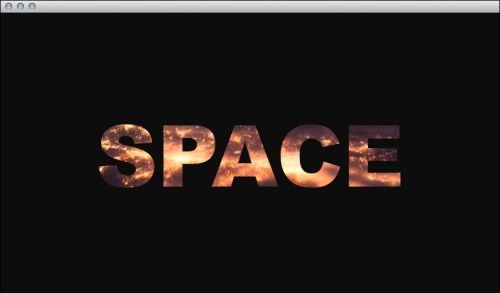In this recipe, we will learn how we can use text as a mask for a movie using a simple shader program.
In this example, we are using one of the amazing videos provided by NASA taken by an ISS crew that you can find at http://eol.jsc.nasa.gov/. Please download oneand save it as video.mov inside the assets folder.
We will create a sample Cinder application to illustrate the mechanism. Perform the following steps to do so:
- Include the necessary header files.
#include "cinder/gl/Texture.h" #include "cinder/Text.h" #include "cinder/Font.h" #include "cinder/qtime/QuickTime.h" #include "cinder/gl/GlslProg.h"
- Declare the member variables.
qtime::MovieGl mMovie; gl::Texture mFrameTexture, mTextTexture; gl::GlslProg mMaskingShader;
- Implement the
setupmethod, as follows:setWindowSize(854, 480); TextLayout layout; layout.clear( ColorA(0.f,0.f,0.f, 0.f) ); layout.setFont( Font("Arial Black", 96 ) ); layout.setColor( Color( 1, 1, 1 ) ); layout.addLine( "SPACE" ); Surface8u rendered = layout.render( true ); gl::Texture::Format format; format.setTargetRect(); mTextTexture = gl::Texture( rendered, format ); try { mMovie = qtime::MovieGl( getAssetPath("video.mov") ); mMovie.setLoop(); mMovie.play(); } catch( ... ) { console() <<"Unable to load the movie."<<endl; mMovie.reset(); } mMaskingShader = gl::GlslProg( loadAsset("passThru_vert.glsl"), loadAsset("masking_frag.glsl") ); - Inside the
updatemethod we have to update ourmFrameTexturewhere we are keeping the current movie frame.if( mMovie ) mFrameTexture = mMovie.getTexture();
- The
drawmethod will look like the following code snippet:gl::enableAlphaBlending(); gl::clear( Color::gray(0.05f) ); gl::setViewport(getWindowBounds()); gl::setMatricesWindow(getWindowSize()); gl::color(ColorA::white()); if(mFrameTexture) { Vec2f maskOffset = (mFrameTexture.getSize() - mTextTexture.getSize() ) * 0.5f; mFrameTexture.bind(0); mTextTexture.bind(1); mMaskingShader.bind(); mMaskingShader.uniform("sourceTexture", 0); mMaskingShader.uniform("maskTexture", 1); mMaskingShader.uniform("maskOffset", maskOffset); gl::pushMatrices(); gl::translate(getWindowCenter()-mTextTexture.getSize()*0.5f); gl::drawSolidRect( mTextTexture.getBounds(), true ); gl::popMatrices(); mMaskingShader.unbind(); } - As you can see in the
setupmethod we are loading a shader to do the masking. We have to pass through vertex shader inside theassetsfolder in a file namedpassThru_vert.glsl. You can find this in the Implementing 2D metaballs recipe in Chapter 7, Using 2D Graphics. - Finally, the fragment shader program code will look like the following code snippet, and should also be inside the
assetsfolder under the namemasking_frag.glsl.#extension GL_ARB_texture_rectangle : require uniform sampler2DRect sourceTexture; uniform sampler2DRect maskTexture; uniform vec2 maskOffset; void main() { vec2 texCoord = gl_TexCoord[0].st; vec4 sourceColor = texture2DRect( sourceTexture, texCoord+maskOffset ); vec4 maskColor = texture2DRect( maskTexture, texCoord ); vec4 color = sourceColor * maskColor; gl_FragColor = color; }
Inside the setup method in step 3 we are rendering our text as Surface and then converting it to gl::Texture that we will use later as a masking texture. It is important here to set a rectangle format for masking texture while we are using it as a mask for a movie, because qtime::MovieGl is creating a texture with a frame that is rectangular. To do that we are defining the gl::Texture::Format object named format and invoking the setTargetRect method on it. While creating gl::Texture we have to pass format to the constructor as a second parameter.
To draw a movie frame we are using our masking shader program applied on the rectangle in step 5. We have to pass three parameters, which are the movie frame as sourceTexture, mask texture with text as maskTexture, and the position of the mask as maskOffset.
In step 7 you can see the fragment shader code, which simply multiplies the colors of the corresponding pixels from sourceTexture and maskTexture. Please notice that we are using sampler2DRect and texture2DRect to handle rectangular textures.

